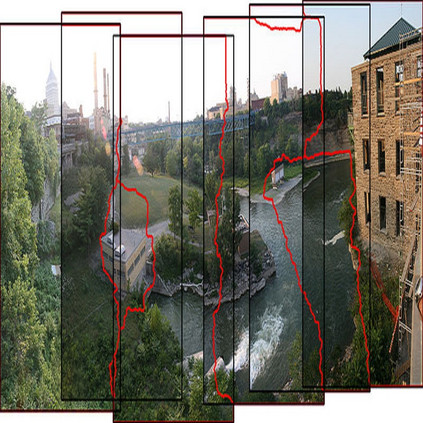Image stitching is to construct panoramic images with wider field of vision (FOV) from some images captured from different viewing positions. To solve the problem of fusion ghosting in the stitched image, seam-driven methods avoid the misalignment area to fuse images by predicting the best seam. Currently, as standard tools of the OpenCV library, dynamic programming (DP) and GraphCut (GC) are still the only commonly used seam prediction methods despite the fact that they were both proposed two decades ago. However, GC can get excellent seam quality but poor real-time performance while DP method has good efficiency but poor seam quality. In this paper, we propose a deep learning based seam prediction method (DSeam) for the sake of high seam quality with high efficiency. To overcome the difficulty of the seam description in network and no GroundTruth for training we design a selective consistency loss combining the seam shape constraint and seam quality constraint to supervise the network learning. By the constraint of the selection of consistency loss, we implicitly defined the mask boundaries as seams and transform seam prediction into mask prediction. To our knowledge, the proposed DSeam is the first deep learning based seam prediction method for image stitching. Extensive experimental results well demonstrate the superior performance of our proposed Dseam method which is 15 times faster than the classic GC seam prediction method in OpenCV 2.4.9 with similar seam quality.
翻译:缝合图像是为了从不同观察位置所拍摄的一些图像中构建全景图像,其视野范围更广(FOV),从不同观察位置所捕捉的一些图像中构建全景图像。为了解决缝合图像中的混凝问题,由缝合驱动的方法通过预测最佳接缝质量避免了图像的错配区。目前,作为OpenCV图书馆的标准工具,动态编程(DP)和GreagCut(GC)仍然是唯一常用的接缝预测方法,尽管两者都是20年前提出的。然而,GC可以得到出色的接合质量,但实际性能不佳,而DP方法效率良好,但接合质量差。在本文件中,我们为了高效率高的接合质量,提出了基于深学习的接合预测方法(DSeam)。为了克服网络中接合描述的难度,动态编程(DP)和GreagC(GC)仍然是用来监督网络学习的接缝质量制约。由于选择一致性损失的制约,我们隐含了面界限,将面框边界定义为海深处,并将深度预测转换为海中的海中度预测变成海中面质量。我们基于海的深度预测方法,以15号的模拟模拟模拟模拟的图像的模拟,因此,拟议的方法是学习了我们基于海洋的深度预测方法。


